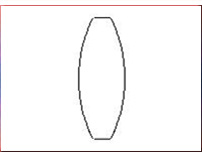Plano Convex

These Lenses have one Convex surface and have a positive focal length. They converge the incident light. They can be used as simple magnifiers and also in a variety of applications for collecting and focussing light.
Bio Convex Lenses

These lenses have two convex surfaces. They can be either symmetrical (both surfaces having the same radius) or asymmetrical (both surfaces having different radii). They have a positive focal length and converge light.
Plano Concave Lenses

The name itself indicates that these lenses have one plane i.e. flat and one inward curved surface. They have a negative focal length & diverge light. They form only virtual images which are seen through the lens. They are useful to expand light beams or to increase focal length in an optical system.
Bio Concave Lenses

Bio Concave Lenses have two inward curved surfaces. They have negative focal length and are used similarly. They can either be symmetrical or asymmetrical.
Meniscus Lenses

A Meniscus lens has one concave and convex surface. It can either have a positive or a negative focal length depending on the radii of the two surfaces. This lens can be used in combination with other lenses to increase or decrease the focal length of the system.
Ball Lenses
These are polished glass balls and can be made with high diameter tolerances. Useful in fiber optics.
Achromatic Doublets Ans Triplets

These are lenses having 2 or 3 components of different optical glasses. They are corrected for spherical and chromatic aberrations. They can either cemented together or air-spaced and mounted. The air-spaced version can be used in high power Lasers (e.g. for 1064nm YAG laser). They are very useful for imaging applications. Those with negative focal lengths can be used as Barlow lenses with telescope eyepieces. 3-element cemented achromats are used as high-power magnifiers.
